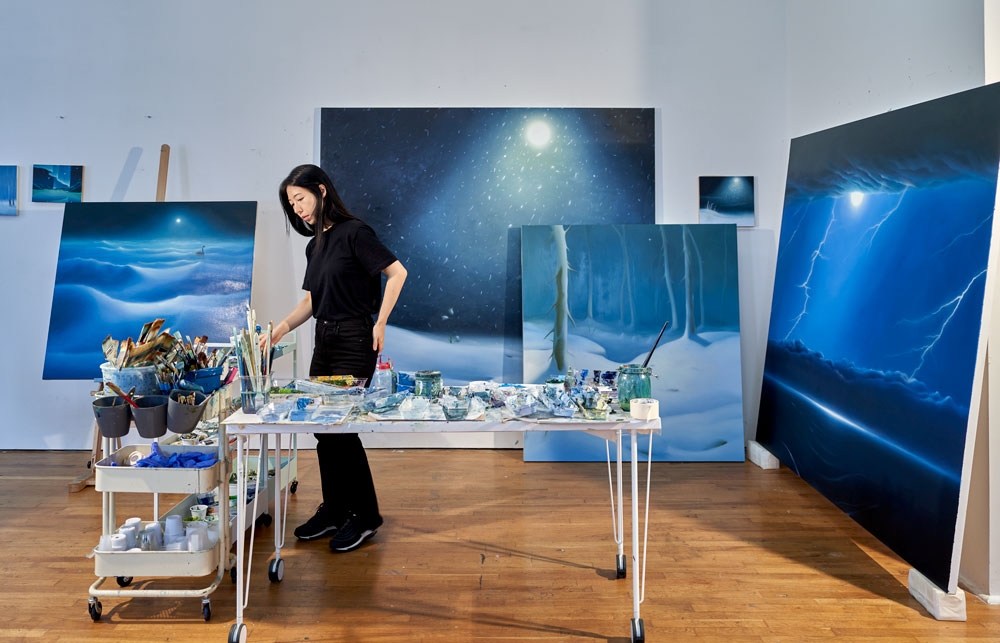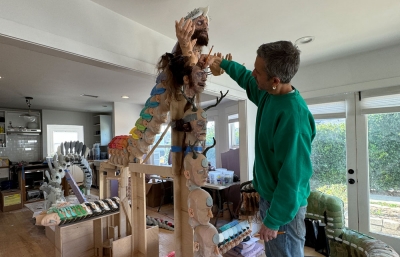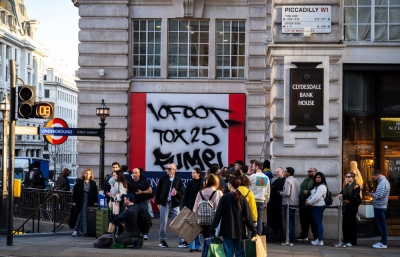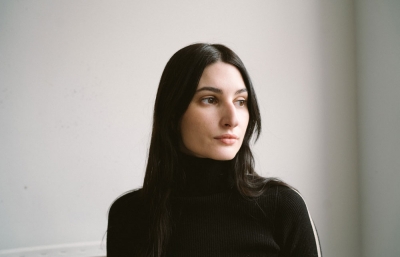Sarah Lee
At Moonlight
Interview by Shaquille Heath // Portrait by Matthew Hermann
When was the last time you sat in stillness? Turned off your phone? Closed your eyes and allowed your brain to neutralize and excavate an instinct deep inside, opening the senses to risk and exposure? Likely not recently. You’ve probably run far away from that place since 2020 when that was the only thing that we knew. You’ve gone back to work. To your friends. To your life. To music and dancing and laughter. Where the sun warms the skin and a cool breeze brushes softly across the face.
Sarah Lee’s mind has not left that place. It is the essence of her artwork, probing the vulnerability of silence and its echoes across nature, where it is most inherent. She paints scenes of a winter wonderland with no footprints to mark the way. A dark ocean where you could blink your eyes and believe the water is the sky. Twisted trees that contort across an unearthly green forest. Moonlight that mimics a spotlight following across a stage. These are the works that make up Lee’s solo exhibition, Two Skies, which were on view at the albertz benda gallery in New York. Mischievous paintings that at first glance evoke serenity but, in actuality, echo a place hidden within the human condition.
There is something so brave about exploring one’s loneliness. To turn over the leaves in a teacup to see darkness and be willing to pour another cup. And most notably, opening these feelings, then broadcasting them to the world in your artwork. Lee’s paintings are not for the valorous warrior. They are for the one cowering in the corner, assurance that the feeling of shadows crawling across the skin is more universal than you’re often made to believe.

Two Skies, 2023. Oil on canvas. 70 x 80 inches | 178 x 203 cm. Image courtesy the artist and albertz benda, New York | Los Angeles. Photo by Adam Reich.
Shaquille Heath: I kind of have an odd first question for you… Do you believe in magic?
Sarah Lee: Oh, that's an interesting question. I'm actually very down to earth. But I appreciate the fantasies humans have created on both individual and cultural levels. It's like many different cultures have fantasized about what they are uncertain of or something that is not controllable, and have created interesting stories about them. I think that’s magical.
Where do you feel more like yourself, in the sunlight or in the moonlight?
Moonlight definitely. It is quieter and more distant, and it requires effort. You have to look up and search for the moon. I like its subtle presence—always there without demanding attention. I’m an introvert, and I am naturally drawn to things that are quietly captivating.
Can you tell me a little bit about where you grew up? I was wondering if you had a lot of access to nature.
I've lived in quite a few places. I was born in Korea, spent my teenage years in Toronto, then studied at the University of Nebraska before transferring to the Art Institute of Chicago. I spent most of my life in a cityscape, and the only time I had a lot of access to nature was in Nebraska. It was such a peaceful place. Almost too peaceful. Have you ever been there?
I have not! But I'm from Utah, so I feel like I get somewhat of the sense of what people mean when they say where they’re from in the way that you did.
Haha, yeah, so you get it. I've never actually met anyone else from Nebraska yet. I lived there for a couple of years before moving to Chicago. So I haven't been around nature much. Maybe that's why I've always dreamt about things that I only see through media, like the Northern Lights. In my recent show, Two Skies, at albertz benda, there is a painting called Northern Lights. Since I've never witnessed them in person, I imagined they'd look like delicate curtains, so I took inspiration from that. Everything I paint is basically from my imagination, which is why sometimes it might not seem realistic or true to nature.

Luna Moths, 2023. 70 x 60 inches | 178 x 152.5 cm. Image courtesy the artist and albertz benda, New York | Los Angeles.
Photo by Thomas Müller.
Photo by Thomas Müller.
Do the landscapes start with somewhere familiar, whether looking at photos in books or watching a movie where you see something that kind of inspires you?
Yes, I collect many nature photos and screenshots from documentaries, movies, and animations. I'm particularly drawn to the backdrops of specific nature scenes. For example, in one of my favorite Netflix documentaries, My Octopus Teacher, the narrator dives into a dense kelp forest that almost looks like a dark palm forest from another planet. The way the sunlight pierces the kelp, creating spotlight-like beams, is both bizarre and breathtaking. In one of my paintings, Snowdrop, I mimic the spotlight effect of moonlight to create a stage for the snowdrop flower. This work was inspired by the lighting I saw in the kelp scenes from the documentary.
One of the things that comes to mind in the fairytale is Snow White. You know, when she's walking through the forest and approaching the evil witch's house. It's nighttime, and it feels like the trees are moving and watching her. That came to mind when I first saw your work.
Right. I read a lot of fairy tales when I was young, and I actually read Snow White again when I became an adult. I was searching for the original book’s illustrations. When I read it again, I was quite shocked at how dark the story was, with scenes of a child lost alone in a nighttime forest or a young girl targeted by a powerful queen.
Do you prefer reading the story to watching the movie? Does this pertain to other fairy tales as well?
I like both for different reasons. When I read fairy tales or short stories, I'm more focused on imagining non-visual sensations, such as the scent of the air, humidity, and the feeling of warmth or cold on my skin. These elements directly connect me to color. When I watch a movie, I'm more geared towards collecting visual fragments that I can potentially use in my work. But sometimes, it's not easy to find interesting moments in typical animation movies, like Disney's, because the backdrops can be such a cliché. They're often too pretty to be intriguing.

Snowdrop, 2023. Oil on canvas. 70 x 80 inches | 178 x 203 cm. Image courtesy the artist and albertz benda, New York | Los Angeles. Photo by Adam Reich.
Yeah, it is interesting how Disney romanticizes a lot of these scary stories. Even, you know, like The Little Mermaid, right? That’s a very tragic story in actuality!
It’s a horrible story! Actually, when I was in art school, there was a class called “Criticism about Disney Movies.” It was one of my favorite classes. We just watched Disney movies all day and would talk about what's wrong with them.
That would be really fun! What are some other fairy tales or stories that have inspired your work?
I don't know if you're familiar with Bernard Werber's fiction. The Tree of Possibles is one of my favorite short stories. I first read his book as a teenager and was fascinated by his imagination and the unique way he perceives the world. Since then, I've collected every single book he has published, and I'm still adding to the collection. His other book, The Cats of Tomorrow, is also intriguing, as it presents the story entirely from a cat's perspective.
Oh, that's so interesting! No, I've never read it. I'll have to add that to my list.
It's a very easy book. It's usually for teenagers but I do think you’ll like it.
What is your favorite season? What's your favorite time of the year?
You can probably tell, but I've always had a soft spot for the Christmas season. In fact, my Korean name, Sul Hwa, literally means "Snow Flower." I was born in November, and my mom often recalls how it snowed heavily that night. So, I've always felt a strong connection to winter. I may not be the best at handling the cold, but my mood tends to be happier during the winter months. A lot of my friends are summer enthusiasts, but I just can't see myself living somewhere like California, a place without snowy winters.
Your name is so beautiful! It is very different to have your favorite time of year be winter. Winter can be such a rough season to endure. And yet you paint it with such admiration. Did you always gravitate toward landscapes?
I used to make abstract paintings. They were pretty ambiguous because I divided spaces with horizon lines, meaning they could be interpreted as either landscapes or abstractions. But my transition to painting imaginary landscapes began during the pandemic. At that time, I had recently moved to New York from Chicago. I barely knew anyone, and with everything shutting down, I was in complete isolation. All I did all day was paint. I started using darker and bluer hues and painting night scenes because I felt every day was like an endless night. It sounds depressing, but I think I was madly in love with what I was doing. For the first time, I had no distractions; each painting became an escape from reality and took me to different places. Since then, I have continued to paint landscapes.

Is that something that you’ve continued to have the desire to paint now that it somewhat feels like the end of the pandemic?
Although the pandemic is where it started, my approach to work now transcends that event. It opened my eyes to ways of conveying emotions through specific aspects of nature. So, to answer your question, yes, I do see myself continuing with landscape painting. There's still so much out there I want to explore. I'm also trying to broaden my scope, possibly painting different times of the day or various moods. In my recent show, Two Skies, there are a couple of green paintings that were a bit challenging for me, but I eventually enjoyed them.
What was hard about painting the green paintings?
When I use a brighter palette in landscape painting, it easily turns into a happy painting. I don't know why, but I feel like that's not 100% real. There has to be some darkness to make the light precious.
I understand! And I really appreciate that. You also wield this beautiful glowing technique that really makes your work feel very, like we were saying, kind of magical and mystical. When did you begin to utilize that process?
It happened gradually. I began experimenting with the airbrush technique when I was in grad school, at a time when not many artists were using it as a painting tool. So, I had to face many failures and figure out how to use it. When I finally got the hang of it, I was amazed by how perfectly it could mimic glowing light. So, I started incorporating glowing dots, like fireflies, into my abstract paintings. After heavily using the airbrush for about 5–6 years, I became quite ill because I wasn't properly wearing a respirator and other protective gear. I had no idea it was damaging my lungs. Consequently, I had to give up on the airbrush and transition to oil painting since it was the medium that allowed me to continue capturing that glowing light effect.
It sounds like grad school was very influential on your work.
I think so. I attended two graduate schools. The first was in Korea. Having left my country at 15 and lived as a foreigner for most of my life, I wanted to experience what it was like to be in an art community in my home country. So, I went to Seoul National University. It turned out quite differently from what I expected. The program prioritized developing ideas and concepts over a medium. In contrast, the art education I received in Chicago emphasized building techniques that would allow me to realize those ideas. I spent those two years in Korea searching for what I wanted to pursue as an artist, which I now believe laid a strong foundation for me. After that program, I decided to return to Chicago. The Art Institute of Chicago had a reputation for its painting program, and painting was what I wanted. My grad school experience in Chicago was chill and fun. The program allowed me to explore all kinds of painting styles, from abstraction to screen printing and sculptural paintings. After all these, it's ironic to me that I ultimately chose the most traditional genre: landscape painting.

Among Trees, 2023. Oil on canvas. 50 x 52 inches | 127 x 132 cm. Image courtesy the artist and albertz benda, New York | Los Angeles. Photo by Adam Reich.
When you begin a piece, do you know what you want to paint? Or does it come to you as you're working?
Yes. It comes to me when I mix colors. I pre-mix most of the colors that I think I'll use before I start painting. I have a "mixing day" and spend the entire day creating about 20–30 color palettes. Once I have all the colors, they kind of set the atmosphere for the work. For example, when I have a lot of dark blues, the painting usually turns out to be a nighttime scene. And when I have a lot of grays and whites, it leads me to foggy or winter landscapes.
And then you just start to put it on the canvas, and it all begins to come together?
Right. There are a lot of failed layers underneath the final painting because I start with a blank canvas and no sketch. As I build up layers, the image comes to me. Doing a full sketch makes me lose excitement. I'd rather not know about it.
Oh, that's so interesting! Do you listen to any music when you're working?
Yes. I don't like to work in silence. So I've got all sorts of stuff playing in the background. Sometimes, it’s a Netflix series or a movie like La La Land that I've watched countless times. Or I listen to music, anything from pop to classical. To be honest, I'm not always fully tuned in to what's playing. It's more about setting a vibe or just having some white noise.
Yeah, totally. It’s interesting because your works, although there is movement, invoke this feeling of serenity. It's funny to hear you say that you're watching Netflix as you're doing it. Do you like stillness yourself? Or is that something that you have just gravitated to in your paintings?
I think the answer is both yes and no. I like stillness in my work. When I see my paintings, I feel conflicted emotions. I want to be in that place, but I also don't want to be there. It's a very lonely place. I want to observe it from a safe distance. That's why the idea of a painting as a "window" resonates with me. So, to put it simply, while I have a love for silence, I'm also afraid to be immersed in it.

Night is Falling, 2023. Oil on canvas. 12 x 13 inches | 30.5 x 33 cm. Image courtesy the artist and albertz benda, New York | Los Angeles. Photo by Adam Reich.
Not to be a therapist about it… Haha, have you thought about that more? What about the silence that scares you?
Haha, there's no easy way to explain this, but there's this deep feeling of being alone, hiding in a corner of my mind, that I just can't shake off. I'm lucky to have a wonderful family and to be surrounded by truly amazing friends, but this feeling... it seems larger than just my personal experience. I'm convinced that this sense of solitude is something all of us humans have—especially when we think about how short life is and how vulnerable we can be. The silence reminds me of it. Maybe I can put it this way: think about how we handle fear or the unknown. We give menacing hurricanes names. We make wishes upon shooting stars. We make stories about the full moon. All these actions are our ways of comforting ourselves against our fears. And by painting, I'm comforting myself, hoping that it resonates with others as well.
Silence scares me too! You’re not alone in that. So through your work, in a way, you're exploring your own fears?
Yes, exactly.
Sarah Lee’s solo show, Two Skies, was on view at albertz benda in NYC this past fall // This interview was originally published in the WINTER 2024 Quarterly // Sulhwalee.com






